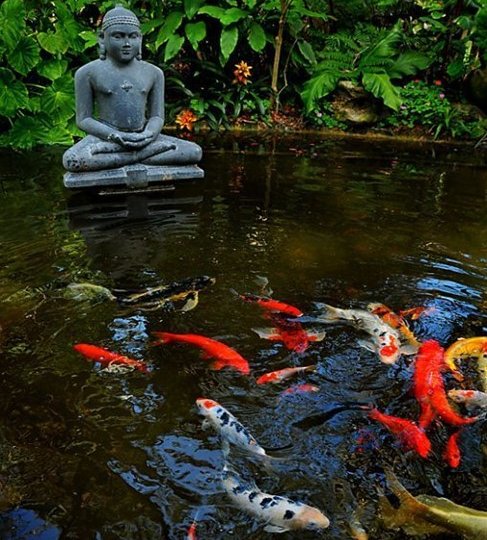“Can you eat Koi fish?” might initially seem unusual.
Commonly, Koi fishes are admired in ponds or aquariums and are rarely considered for culinary purposes.
This perception is influenced by their beauty and cultural significance, particularly in Asian countries where they are often seen as prized outdoor fixtures.
In this article, we’ll briefly explore the background of Koi fish before addressing their edibility and culinary uses.
The Significance of Koi Fish in Culture

Koi fish have been cherished for centuries as pets and symbols in various cultures.
These fish are known for their long lifespan, living up to 70 years in captivity, with an average of 30-40 years.
More than their longevity, Koi fish hold significant cultural and spiritual importance, often symbolizing peace, friendship, and wealth.
What sets Koi apart are their distinctive patterns and colors, a result of meticulous breeding.
Originating from the common carp, Koi have evolved through selective breeding, which began around 6200 BC in China.
This process highlighted their aesthetic appeal, transitioning their value from primarily food sources to symbols of beauty and cultural significance.
In many Asian countries, particularly Japan and China, Koi are celebrated in water gardens, embodying various meanings, from love and prosperity to luck.
This blog section aims to provide context on Koi fish’s cultural and historical background, setting the stage for understanding their less common role in cuisine.
Koi Fish in Japanese Culture and Cuisine

While initially bred in Japanese rice paddies for practical purposes, Koi fish have transcended their original role to become a prominent cultural symbol in Japan.
They are not just aquatic pets but embody a range of meanings in Japanese society.
One notable variety is the Kohaku, characterized by its white body with red markings, symbolizing purity and life.
Other varieties, like the golden Kin-Rin and platinum-colored Ogon Koi, represent wealth and success, respectively.
With its flowing fins, the Butterfly Koi is an emblem of beauty and harmony.
These varieties, among others, demonstrate the rich cultural tapestry associated with Koi fish in Japan, where they are revered for their beauty and symbolic meanings.
Though less common, the culinary use of Koi fish does exist. Koi is occasionally featured in dishes like fish tacos or curry recipes in certain regional cuisines.
However, given their esteemed status in Japanese culture, this is far from mainstream.
Can You Eat Koi Fish? Edibility and Taste.

So, can you eat Koi fish? The answer is yes. Koi fish, not being poisonous, are technically edible.
They are similar to common carp in taste and texture, which brings us to an important consideration: the palatability of carp.
Carps, including Koi, are not typically renowned for their flavor.
Often, they are not the preferred choice in fine dining due to their distinctive taste, which some describe as muddy or oily.
This taste largely stems from their diet, which includes algae, fruits, and other fish, influencing their flavor profile.
Interestingly, Koi fish are widespread in Asia, Europe, and North America, where they have been introduced, sometimes as an invasive species.
The environment plays a crucial role in the taste of these fish.
For instance, in their native habitats like Japan and China, where they are raised in well-maintained waters, Koi can have a more palatable flavor than those from less ideal environments.
Reasons to Consider Eating Koi Fish

While Koi fish are not commonly found on menus, there are reasons why one might consider eating them.
Historically, Koi were bred for consumption, though this practice has significantly declined due to their evolving relationship with humans.
However, Koi is still featured in traditional dishes in some cuisines, such as Thai and Bengali. In parts of Europe, Koi is also used in culinary preparations.
One compelling reason to try Koi fish is when seeking an authentic cultural experience. Sampling local cuisine while traveling can offer a unique insight into the region’s culture and history.
Eating Koi in regions where it is customary can be part of this exploration.
Nutritionally, Koi fish are similar to other fishes, particularly their ancestor, the common carp.
They provide a comparable nutritional value, making them a viable, though unusual, option for diversifying their diet.
Reasons Against Eating Koi Fish

Despite their edibility, there are several reasons why you might choose not to eat Koi fish.
Firstly, Koi have become popular pets, known for their ability to recognize and interact with their owners.
This personal connection makes them more than just fish; they are companions, capable of learning and responding to their environment and even their names.
Culturally, Koi fish hold a sacred status in countries like Japan and are considered symbols of good luck in Southeast Asia.
Their ornamental and spiritual significance often outweighs their culinary value. Eating Koi could be seen as disrespectful in cultures where they are revered.
The cost of Koi fish is another deterrent. Due to their ornamental beauty and the intricate patterns they sport, Koi can be quite expensive.
Consuming an animal valued more for its aesthetic and symbolic significance than its taste is not appealing to many.
Furthermore, the taste of Koi fish, often described as oily or muddy, does not make them a desirable culinary choice, especially when more palatable fish are available.
Their texture and flavor, influenced by their varied diet, do not generally align with conventional taste preferences for seafood.
Conclusion
In summary, while Koi fish are technically edible, they offer more value as cultural symbols and pets than as a food source.
Their historical significance, ornamental beauty, and potential as companions make them unique beyond the culinary realm.
Given their cultural importance, especially in Asian societies, and their less-than-desirable taste, Koi are best appreciated in ponds rather than on plates.
Ultimately, the decision to eat Koi fish rests on individual preferences and cultural sensitivities.

